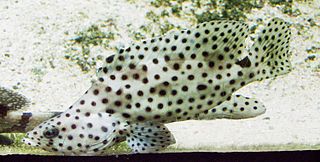
The Serranidae are a large family of fishes belonging to the order Perciformes. The family contains about 450 species in 65 genera, including the sea basses and the groupers. Although many species are small, in some cases less than 10 cm (3.9 in), the giant grouper is one of the largest bony fishes in the world, growing to 2.7 m in length and 400 kg (880 lb) in weight. Representatives of this group live in tropical and subtropical seas worldwide.
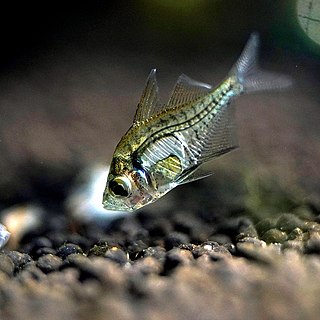
Parambassis is a genus of freshwater fish in the Asiatic glassfish family Ambassidae of order Perciformes. The type species is the Iridescent glassy perchlet. These fishes originate mostly from Southeast Asia, but the species range across the Indomalayan and Australasian realms, from Pakistan, China and India south through Indonesia, New Guinea and Australia. Although primiarly found in fresh water, a few species can also be seen in brackish water. The Parambassis species range in maximum size from 4–24 cm (1.5–9.5 in), but they are similar in appearance, with a lozenge-shaped form, typical perciform fins, and semitransparent or transparent body. Several of the species are common food fish in local markets, and some are kept as aquarium fish.

Epinephelus is a genus of marine ray-finned fish, groupers from the subfamily Epinephelinae, part of the family Serranidae, which also includes the anthias and sea basses. They are predatory fish, largely associated with reefs and are found in tropical and subtropical seas throughout the world. They are important target species for fisheries.

Anthias are members of the family Serranidae and make up the subfamily Anthiinae. Anthias make up a sizeable portion of the population of pink, orange, and yellow reef fishes seen swarming in most coral reef photography and film. The name Anthiidae is preoccupied by a subfamily of ground beetles in the family Carabidae created by Bonelli in 1813 and this grouping should be called the Anthiadinae. However, both the 5th Edition of Fishes of the World and Fishbase give the Serranid subfamily as "Anthiinae".
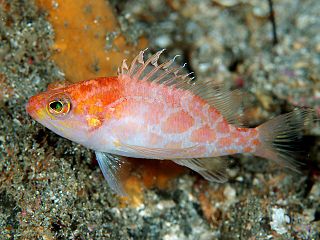
Plectranthias is a genus of ray-finned fish in the subfamily Anthiinae, part of the family Serranidae, the groupers and sea basses. They are found in the Atlantic, Indian and Pacific Ocean.
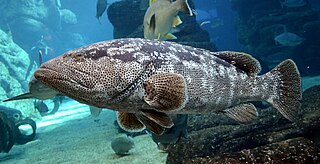
The Malabar grouper also known as blackspot rockcod, estuary rockcod, giant rock cod, greasy grouper, Malabar rockcod, Morgan's cod or speckled grouper, is a species of marine ray-finned fish, a grouper from the subfamily Epinephelinae which is part of the family Serranidae, which also includes the anthias and sea basses. It is found in the Indo-Pacific region. It has entered the Mediterranean Sea from the Red Sea by way of the Suez Canal as a Lessepsian migrant.
Pseudanthias regalis is a species of marine ray-finned fish in the subfamily Anthiinae of the family Serranidae, the groupers and sea basses. It is endemic to French Polynesia.
Yellow-fin may refer to one of the following species of fish:

The areolate grouper, also known as the yellowspotted rockcod, areolate rockcod, green-spotted rock-cod, squaretail grouper or squaretail rock-cod, is a species of marine ray-finned fish, a grouper from the subfamily Epinephelinae which is part of the family Serranidae, which also includes the anthias and sea basses. It inhabits coral reefs in the Indo-Pacific region. They are produced through aquaculture and commercially fished. They currently face no threats to their survival.>
Gerald Robert "Gerry" Allen is an American-born Australian ichthyologist. His career began in 1963, when he spent a semester at the University of Hawaii, where he also received a PhD in marine zoology in 1971. In 1972, Allen wrote his doctoral thesis on the systematics and biology of the anemone fish.
Giganthias is a small genus of marine ray-finned fish belonging to the Anthiinae subfamily, which is part of the family Serranidae. the groupers and sea basses. It contains two species from Japan, Taiwan, and Indonesia.

Hypoplectrodes is a genus of marine ray-finned fish belonging to the Anthiinae subfamily, part of the family Serranidae, the groupers and sea basses. It contains eight species; six of which are endemic to Australia, with one species endemic to New Zealand, and another found in the southeastern Pacific Ocean.

Chelidoperca, commonly known as perchlets, is a genus of marine ray-finned fishes which is a member of the subfamily Serraninae of the family Serranidae, which includes the groupers and anthias. They are found in the Indo-Pacific region.

Pseudorhabdosynochus is a genus of monopisthocotylean monogeneans, included in the family Diplectanidae. The type-species of the genus is Pseudorhabdosynochus epinepheli .
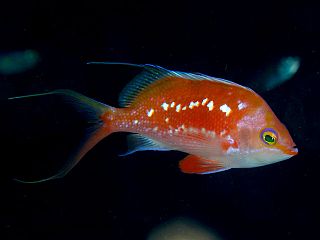
Sacura is a genus of fish in the family Serranidae found in the Indian and Pacific Ocean.

Jean-Lou Justine, French parasitologist and zoologist, is a professor at the National Museum of Natural History in Paris, France, and a specialist of fish parasites and invasive land planarians.

The ara, otherwise known as the saw-edged perch or the Dageumbari (다금바리) is a species of marine ray-finned fish from the monospecific genus Niphon which is in the monotypic tribe of the Niphonini which is part of the subfamily Epinephelinae of the family Serranidae, the groupers and sea basses. It is found in the Western Pacific Ocean from Japan south to the Philippines where it inhabits rock reefs and inshore waters with rocky sea beds, This species can grow up to 1 metre (3.3 ft) in total length. The tribe Niphonini is the sister to the other four tribes of Epinephelinae and it has been posited that it represents a basal lineage within this subfamily. The ara was first formally described in 1828 by Georges Cuvier in the Histoire naturelle des poissons which he co-authored with Achille Valenciennes, the type locality was given as the Sea of Japan.

The Spanish flag is a species of marine ray-finned fish, a grouper from the subfamily Epinephelinae which is part of the family Serranidae, which also includes the anthias and sea basses. It is found in the western Atlantic Ocean. It is the only species in the genus Gonioplectrus.

The Serraninae is a subfamily of perciform ray-finned fishes in the family Serranidae. It is made up of ten genera and 87 species.
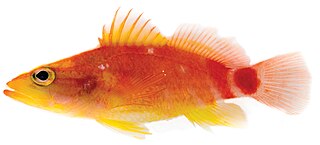
Plectranthias ahiahiata, the sunset perchlet, is a fish of the family Serranidae, subfamily Anthiinae. It is believed to be endemic to Rapa Nui in the South Pacific. It was discovered at 90m depth during mesophotic coral ecosystem exploration by the deep diving team from the California Academy of Sciences.















